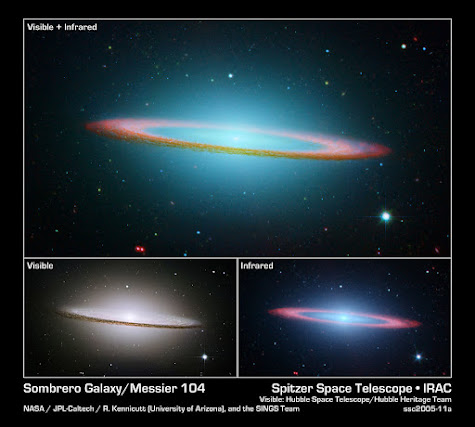Introduction:
The universe is a canvas painted with countless galaxies, each telling its own unique story through the interplay of stars, gas, and dust. Among these celestial marvels, the Sombrero Galaxy stands out as a captivating masterpiece, captivating astronomers and stargazers alike with its striking appearance and enigmatic nature. Known officially as Messier 104 (M104), this spiral galaxy located in the constellation Virgo has earned its nickname from its resemblance to the broad-brimmed Mexican hat. In this comprehensive exploration, we embark on a journey to unravel the mysteries of the Sombrero Galaxy, delving into its structure, composition, formation, and significance in the cosmos.
The Sombrero Galaxy: A Visual Spectacle:
At first glance, the Sombrero Galaxy presents itself as a stunning celestial spectacle, captivating observers with its mesmerizing features. Its most prominent characteristic is the dark, thick band of dust that stretches across its central bulge and disk, creating the unmistakable impression of a sombrero hat suspended against the backdrop of the cosmos. This dust lane, composed of dense interstellar material, obscures the light emanating from the galaxy's inner regions, lending it a mysterious and alluring aura. The Sombrero Galaxy's spiral arms, though less pronounced than those of many other spirals, spiral outward from its central bulge, adorned with clusters of bright young stars and nebulae where new stars are born. Surrounding the galaxy's central regions is a faint, extended halo, home to older stars and globular clusters that orbit its core in a dance of cosmic proportions.
Structure and Composition:
Beneath its captivating exterior lies a complex and intricate structure, revealing insights into the Sombrero Galaxy's composition and evolutionary history. At its heart lies a prominent bulge, a dense concentration of stars and stellar remnants that form the galaxy's central hub. Surrounding the bulge is a flattened disk, where the majority of the galaxy's stars, gas, and dust reside. Here, spiral arms adorned with luminous star clusters and nebulae spiral outward, tracing the intricate patterns of cosmic evolution. The Sombrero Galaxy's dust lane, bisecting its bulge and disk, serves as a testament to the interstellar material that fuels the process of star formation and shapes the galaxy's dynamic landscape. Beyond its visible components lies a vast halo, extending far into the cosmic depths and harboring ancient stars and globular clusters that bear witness to the galaxy's storied past.
Formation and Evolution:
The story of the Sombrero Galaxy's formation and evolution unfolds over billions of years, shaped by the relentless forces of gravity, gas dynamics, and stellar feedback. Like all galaxies, the Sombrero Galaxy traces its origins back to the early universe, emerging from primordial clouds of gas and dust that coalesced under the pull of gravity. Over time, these nascent structures underwent a process of hierarchical assembly, as smaller galaxies merged and accreted to form larger, more massive systems. The Sombrero Galaxy's distinctive appearance, characterized by its prominent bulge and dust lane, bears the hallmarks of a rich evolutionary history shaped by interactions with neighboring galaxies and the ongoing process of star formation and stellar evolution within its own boundaries. As stars are born, live out their lives, and eventually die, they enrich the galaxy's reservoir of interstellar material with heavy elements, perpetuating a cycle of renewal and transformation that continues to shape its destiny.
Significance and Scientific Insights:
Beyond its aesthetic allure, the Sombrero Galaxy holds significant scientific value as a laboratory for studying the processes that govern the formation and evolution of galaxies. Its unique combination of features, including its prominent bulge, extensive dust lane, and faint halo, offers astronomers a wealth of opportunities to probe the underlying physical mechanisms that drive galactic dynamics. By studying the distribution and properties of stars, gas, and dust within the Sombrero Galaxy, researchers can gain insights into the conditions that govern star formation, the role of dark matter in shaping galactic structure, and the mechanisms responsible for triggering galaxy-wide phenomena such as supernovae and black hole accretion. Moreover, the Sombrero Galaxy's proximity to Earth, relative to other galaxies, facilitates detailed observations across a wide range of wavelengths, from radio to gamma rays, allowing astronomers to piece together a comprehensive picture of its cosmic tapestry.
Conclusion:
In conclusion, the Sombrero Galaxy stands as a testament to the beauty and complexity of the cosmos, offering a window into the intricate processes that shape galaxies throughout the universe. From its striking appearance to its rich evolutionary history, Messier 104 embodies the wonders of the cosmos, inspiring awe and fascination among astronomers and enthusiasts alike. As our understanding of the Sombrero Galaxy deepens through ongoing observations and theoretical studies, we gain valuable insights into the fundamental principles that govern the cosmos, enriching our appreciation of the vast and diverse tapestry of galaxies that populate the universe.




Comments
Post a Comment